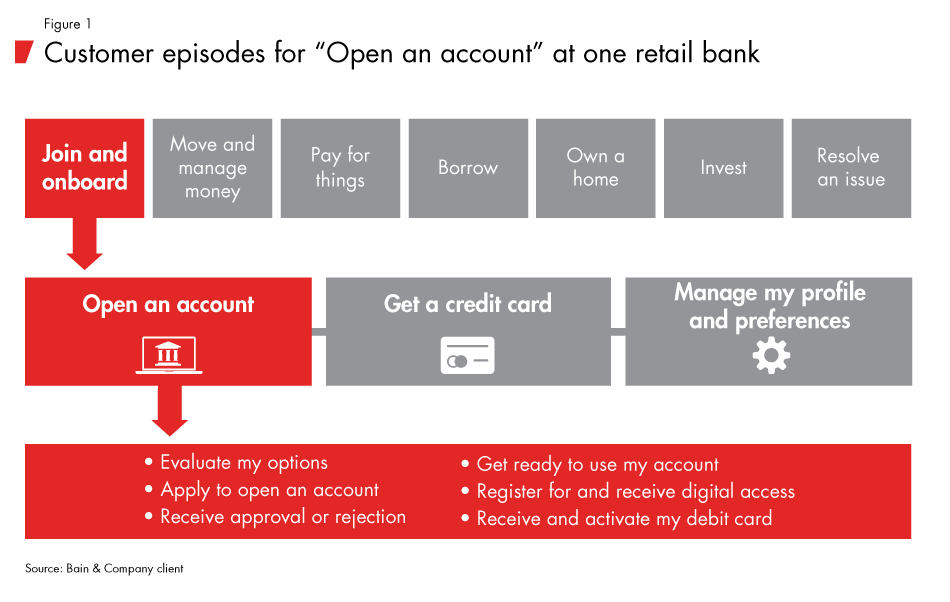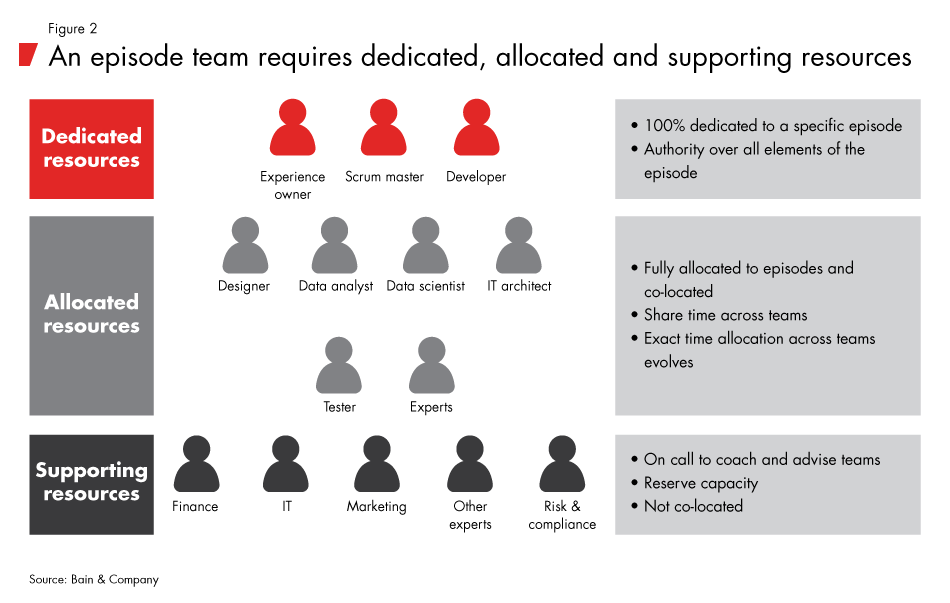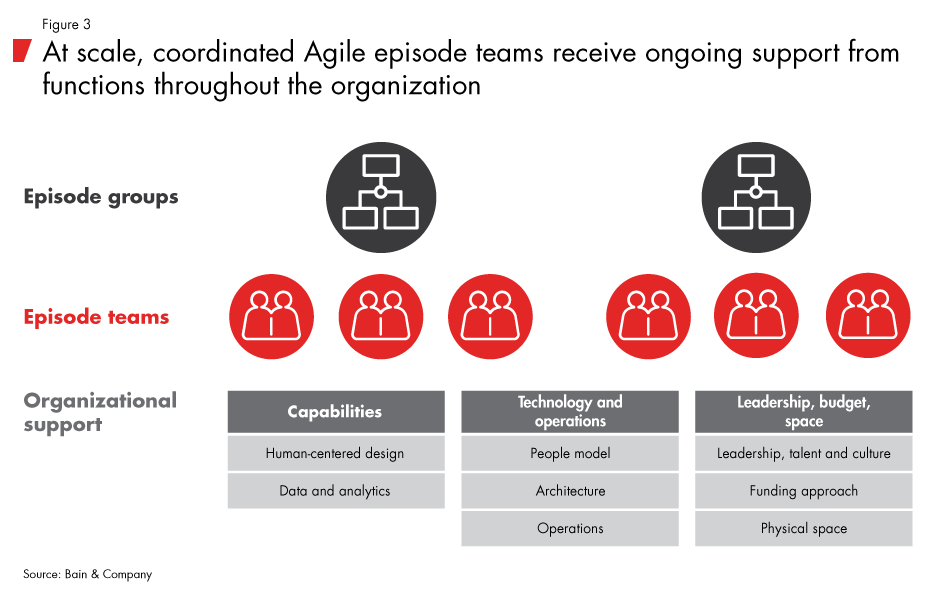Brief

Executive Summary
- More companies now emphasize the entire experience surrounding a product or service. But how do they improve the experience, or fix a broken one?
- For many, the key unit of management has become the customer "episode," and the core method is Agile. An episode consists of all the activities involved to successfully fulfill a customer's need.
- While most Agile to date has focused on software development, improving an episode requires coordinating every factor that affects it, including product features, policies, processes, channels and technology.
- Therefore, the team that owns an individual episode should comprise members from all the relevant functions.
Most companies take an internally oriented approach to organizing around products, processes and functions such as risk management and marketing. But a few pioneering companies have begun to organize around how customers experience their products and services. They have decided that the well-developed metrics and processes for product and functional management don't provide a reliable compass for tracking the overall experience.
For these companies, the key unit of experience management shifted to the customer "episode." And the core management method became Agile. They flipped the organizational pyramid to empower cross-functional teams to own different episodes, with clear goals, accountability and authority over each episode.
An episode consists of all the activities involved to fulfill a customer's need (see Figure 1). If the episode is "I need to replace a lost credit card," the episode ends successfully when the customer receives and activates the new card, then can make purchases again. Taking an episode approach changes how work gets done and decisions get made: primarily through Agile teams, with each responsible for designing or improving a particular episode from start to finish.

Phil Sager: Experience Is the New Product; Here's How to Manage It
Episodes are the key to successful customer experiences.
Managing by episode has become the most effective way to strengthen customer relationships. With digital natives such as Alibaba or Amazon setting the standard for ease of use and personalization, consumers have come to expect pretty much every episode with any business to be that easy. Except most are not. Too many episodes might have come straight out of a Kafka novel.
Consider the broken bill-payment process at a credit card company, as illustrated by one customer's experience. Her payment went astray, and she could not figure out what happened by looking online, so she called customer service. The agent was friendly but could not provide an answer, so he opened an investigation and promised a call back soon. However, the next call came from collections, along with late fees and interest charges. This customer persisted and was bounced to a supervisor, but even then it took days to sort out the mess. She took pains to write to the CEO, who forwarded her note to his management team with an ultimatum to prevent this sort of problem.

A cross-functional game of pass the blame ensued: It was operations' fault because the payment did not post properly in the first place. No, customer service was at fault because it did not resolve the ticket quickly. Collections got blamed because it should not call a customer with an open ticket. The policy on late payment fees also came in for criticism. Months later, the credit card company put a procedure in place to avoid this particular problem, but it remains plagued by hundreds of similar problems.
The credit card firm is hardly an outlier. Many executives understand that they need to improve the experience of interacting with their company. But despite huge investments of energy and resources, most companies still fall far short of customer expectations for a simple and easy experience.
One reason is that virtually every employee now affects the overall customer experience, even employees who do not directly interact with customers. Most individual episodes cross corporate functions, with any change requiring decisions that span compartmentalized products, policies, operations, channels and technologies. Yet nobody is accountable until the decision reaches a senior executive. Slogging through consensus among dozens of managers, or escalating to a busy executive, is too slow and cumbersome for the many decisions required to deliver a great experience. Each function, moreover, may have very different goals. For the contact center, the key goal could be reducing the average handling time; for collections, it could be the percentage of delinquent receivables collected. All of these functional goals aim to improve the economics of the business, yet some of the individual goals are at odds with each other and the overall goal of a delightful experience.
Some of the approaches companies have tried to address these problems have yielded only modest gains. For example, "journey mapping" might help identify pain points and waste, but the maps often suffer from a vague definition of "journey." Nor does a map make it easier to reduce waste, provide insight on how to delight customers or hold anyone accountable. Adding a chief customer officer or a customer experience group might create a champion and expertise, but it can add another layer to an already complex system, without conferring the authority to make difficult systemic changes. Delivering reliably delightful episodes, which are simpler and more economical for a company in the bargain, entails a new approach.
Taking Agile beyond software and digital development
Agile methods applied to designing and managing episodes provide a more effective alternative. Agile is best suited to innovation. Confronted with a large, complex problem, Agile teams break it into modules, develop solutions to each component through rapid prototyping and tight feedback loops, and integrate the solutions into a coherent whole. They place more value on adapting to change than on sticking to a plan, and they hold themselves accountable for outcomes (such as growth, profitability and customer loyalty), not outputs (such as lines of code or the number of new products).
At many companies, Agile has become the default approach to software development and, more recently, preferred for digital development projects. However, setting up Agile islands of technology projects will not change how the rest of the business works, because those projects fail to join up with other operations. Improving an end-to-end episode requires coordinating every factor that affects it.
Leading companies have been applying Agile to fix performance gaps in episodes or completely transform them. For example, one European telecommunications carrier designed a new debt-collection episode from scratch. Within four months, dunning calls and bad debt dropped by half, and involuntary churn fell by 15%. At a regional bank, an Agile team refined the "transfer my credit card balance" episode. That generated a tenfold increase in the overall response rate and volume of customers, adding $20 million of revenue per year.
This shift to emphasize customer episodes and manage them through Agile methods has implications potentially as profound as the shift in manufacturing methods more than a century ago. In 1913, Henry Ford's automobile company changed the way factories worked. Ford replaced the job-shop approach, in which teams moved from one assembly station to another, with an assembly line that moved the chassis to the workers and parts. This and other changes to the ways of working led to production time per vehicle dropping from 12 to 1 ½ hours in just a few years, sharply lowering costs and allowing Ford to reduce the price of a Model T from $850 to $260. The staggering increase in productivity allowed Ford to sell an estimated 16.5 million Model Ts—a huge number at that time.
Today, companies are beginning to realize a similar step change as they industrialize their design and improvement of customer episodes. The assembly line provided the means to raise productivity; end-to-end episode management provides a new way of providing better episodes. Of course, while Ford's system depended on top-down command and control, episode management promotes bottom-up authority, within guardrails defined by overall cost and objectives. The experience of pioneering companies suggests that this new model works most effectively through four steps.
1. Define a consistent taxonomy of episodes.
The first task is to break down the customer's high-level needs into the most meaningful episodes. For example, a bank would unpack the overall need of "pay for things" into "pay another person," "set up online bill payment" or "make an international transfer." A company defines an episode by what the customer wants to do, with a clear start and end, and each episode consists of a number of underlying operational processes. Creating a clear taxonomy of episodes, including how they fit together, is essential for focusing team efforts.
Business unit leaders rank episodes based on their own strategic priorities, while also taking into account the emotional impact, frequency and economics of each episode. Some episodes, such as opening a new account, have a big effect on the customer's perception at that moment, but occur infrequently. More mundane episodes could be equally or more important in influencing customer loyalty, because they occur so often. For example, if paying a bill online is clunky and slow, it will persistently annoy customers like a pebble in their shoe. It will also cause them to use a less convenient and more expensive channel, like the contact center, to get the job done. Managers should also determine which episodes represent a large share of overall costs.
It is important to set the right altitude for an episode, in order to focus scarce resources on the highest priorities. Setting the altitude too high ("I need to pay for things") will miss the important details of how customers actually interact with a company. Setting the altitude too low ("I need to pay retailer X") could lead to a proliferation of Agile teams, each competing for resources and losing sight of the broader experience.
2. Assemble cross-functional teams that own individual episodes.
Successful Agile initiatives staff each dedicated team with experts from all the relevant functions (see Figure 2). Once senior executives give the marching orders, the team—not executives—decides what minimum viable product or service to roll out, based on empirical results measured against clear goals.

While customer-facing digital channels typically play a leading role in episodes, the team oversees all elements of the episode across all channels, including stores and warehouses. These channels also must link to the underlying processes and technology that power the channels. Each episode should have one owner. You can still have general managers in each line of business accountable for revenue and profit, but you need one manager who owns how the work gets done.
3. Set clear goals, metrics and fast feedback mechanisms.
When the executive team chooses episodes for improvement, it also sets integrated business outcome goals and metrics for the improvements, which teams and executives can track through an online dashboard. These metrics typically fall into five categories:
-
Customers. The goal is to create loyal customers who stay longer, spend more, contribute suggestions and recommend your company to others, raising their lifetime value. Customer feedback that is given frequently and with little lag, typically through the Net Promoter System®, allows the team to track performance closely, discern root causes of any problems, and make adjustments quickly. The different departments involved in the episode can understand how they contribute to the broader goal.
Teams should elicit both rational and emotional responses to a new episode design. An episode that succeeds along purely numerical metrics might be perceived unfavorably by customers if an agent strikes the wrong tone. In the case of redesigning an insurance claims episode after an auto accident, the rational side focuses on how quickly and easily the insurer gathers relevant data from the customer. The emotional side involves how the agent interacts with the customer as a person who just suffered a potentially traumatic event. Both sides influence the customer's perception of the episode.
- Performers. Feedback mechanisms among employees and others involved in improving the episode, such as independent agents, aim to foster passionate performers who devise new ideas and go the extra mile to delight customers.
- Economics. Metrics should capture the all-in economics of completing an episode, with the goals of reducing waste and increasing revenues. These metrics include the cost of interactions that could have been avoided altogether, time spent waiting for the next step to occur and the opportunity to shift volumes from live channels to lower-cost digital channels.
- Operational performance. These metrics include speed to completion, resolution of a problem at the first contact and a loyalty score for that episode relative to competitors.
- Compliance. These metrics track adherence to regulatory and legal requirements.
Clear goals and detailed metrics help companies close the experience gap with competitors, or widen the lead, based on benchmarking. They ensure that the responsible team knows exactly what it needs to improve and whether it is making progress.
4. Change the operating model to realize benefits of scale.
At scale, the organization will have dozens of coordinated episode teams. Members of the team wear two hats: In addition to their daily work focused on an episode, they remain part of their ongoing community of practice—operations, marketing, analytics, supply chain and so on. When their work on one episode ends, they can easily take their skills to the next episode challenge. Teams also get support from other functions, such as IT, finance and compliance, which allocate resources to help the team whenever needed, rather than putting the request in a queue (see Figure 3). In broadband service, management of a "new home connection" episode involves managers running the retail, call-center and digital sales channels, as well as the back office that processes connectivity orders and the field service operation that does the hook-ups. At retail banks, the episode of setting up a checking account involves several mandated processes, including anti-money-laundering and "know-your-customer" regulations. An Agile team redesigning that process would call on a designated liaison from the bank's regulatory staff for advice and review to ensure compliance.

One of the biggest challenges with Agile episode management concerns budgeting, as the budget currency changes from dollars to Agile team capacity. A company can maintain its three-year view on operational planning, but could adjust that plan on at least a quarterly basis so it can respond quickly to important developments. For example, with Apple's introduction of facial recognition to its new iPhone, a company can revise the backlog of existing teams to focus on incorporating facial recognition technology into the relevant experiences, rather than adding to the development budget and taking months to hire contractors, define requirements and so on.
We have seen scaling up yield three major benefits. The first is a 25% to 50% improvement in speed to market.
Second, labor productivity rises as a company dedicates more people full-time to episodes. A persistent, dedicated team focused on a particular episode becomes truly expert in that episode and learns to work together effectively over time, with metrics oriented to both quality and speed. For the support roles, full-time allocation reduces the friction in responding to team requests and trying to fit them in around other work.
The third big benefit stems from shortening the learning curve. Agile teams look at upcoming items on their backlogs that could overlap with, or depend on, items planned by other teams. With many teams located in one or two cities, they also can talk informally to share insights and practices. They can see each other's work progress, team leaders can meet for lunch, and they can manage interdependencies by walking across the hall.
Even after just a few months, episode teams find they can make faster decisions based on the empirical evidence of what works in each successive sprint. Other benefits accrue over time. Teams avoid too many handoffs, too much analysis or slow treks up the corporate pyramid for a decision. Dedication to a single episode fosters deep expertise and a tighter connection to the customer.
• • •
As companies take the Agile episode approach to scale, this type of management requires a big change in work patterns and decision making. For one thing, it redefines the roles of senior leaders, as they become champions of the customer's perspective. Leaders can no longer think of episode design or the underlying technology and processes as someone else's job; they need a solid understanding of all the factors that contribute to an episode. The approach also requires a deft hand at budgeting, and a tolerance for mistakes that are part of experimentation.
Hiring or developing the right talent, especially for new roles such as the episode general manager, takes time, which may limit the speed of scaling up. The shift will be challenging for organizations characterized by top-down management, complex matrices and functions that tend to operate separately. Yet these organizations must adapt if they want to pick up their pace and avoid being supplanted by more nimble competitors.
Once the teams are up and running, team members love taking ownership of an episode and seeing real customer results in short order. Just as Henry Ford's assembly-line workers became proficient at installing a windshield and found ways to constantly improve that process, Agile teams become expert in all aspects of their particular episode and aim for improvements. In this way, companies can build a great experience for customers at a sharply lower cost, one episode at a time.
Gerard du Toit, Jens Engelhardt, Phil Sager and Karsten Fruechtl are partners with Bain & Company's Customer Strategy & Marketing practice. They are based, respectively, in Boston, Zürich, Toronto and Melbourne.
Net Promoter System®, Net Promoter Score®, Net Promoter® and NPS® are registered trademarks of Bain & Company, Inc., Fred Reichheld and Satmetrix Systems, Inc.




Jens Engelhardt: Experience Is the New Product; Here's How to Manage It
Companies that organize around customer episodes follow a few key steps.